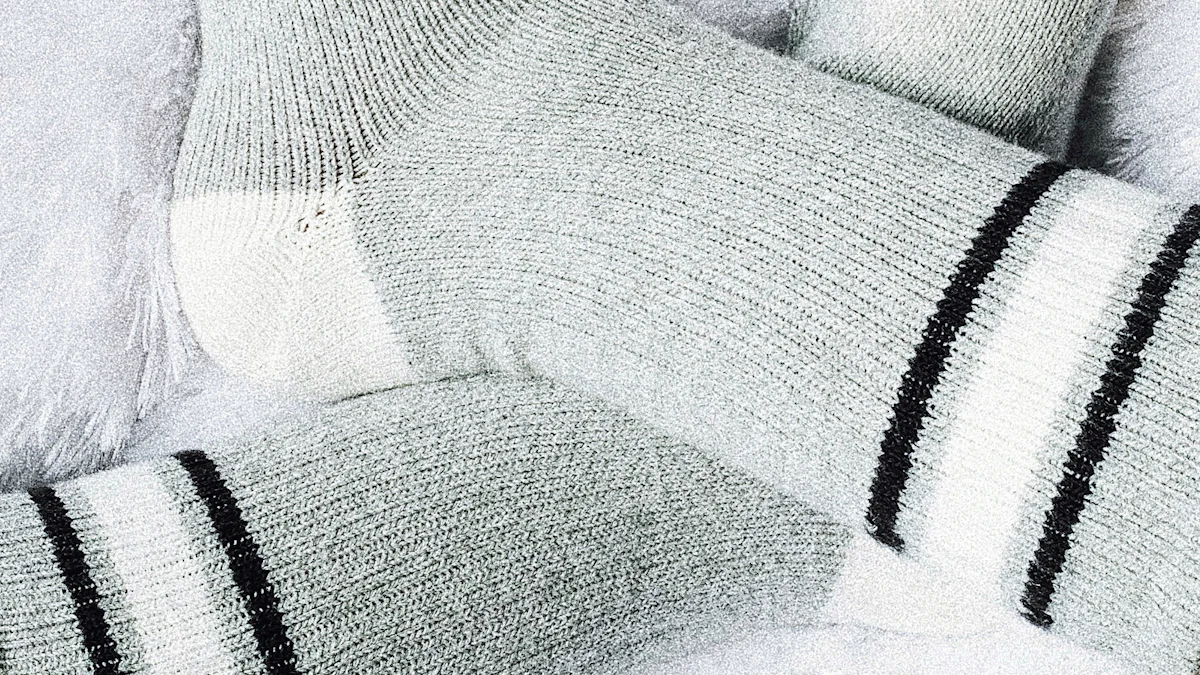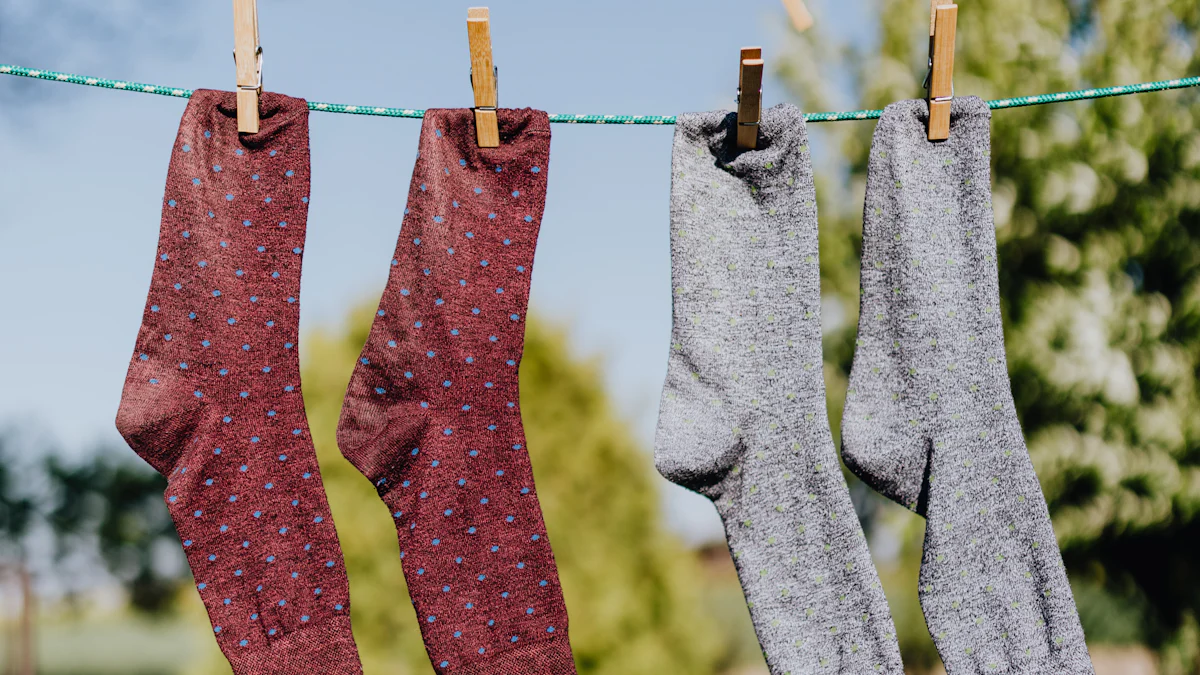Cotton men’s socks have surged in popularity, with the global market estimated to reach USD million by 2028. This trend is driven by their unmatched breathability, comfort, and moisture absorption. Durability is a crucial factor for socks, especially for everyday wear. Customers express a strong preference for natural fibers like cotton due to their softness and breathability.
Introduction to Cotton Socks
When it comes to cotton socks, their preference is rooted in several key factors that make them a popular choice for men’s footwear. Let’s delve into what makes cotton the preferred material for socks and explore its advantages and limitations.
What Makes Cotton Preferred
Cotton socks are favored for their breathability and comfort. The natural fibers of cotton allow for better air circulation, reducing the risk of foot perspiration and discomfort. This breathability helps to keep feet cool and dry by wicking moisture away, reducing the risk of discomfort and foot odor. Additionally, cotton is a relatively durable material, allowing socks made from cotton to withstand regular wear and washing. This durability contributes to their long lifespan, making them a practical choice for everyday use.
Breathability and Comfort
- Natural fibers allow better air circulation
- Reduces foot perspiration and discomfort
- Keeps feet cool and dry by wicking moisture away
The Downside
Despite its many advantages, cotton has some limitations when it comes to moisture-wicking. Unlike synthetic materials like polyester, which excel in moisture-wicking properties, cotton may not be the best option for activities involving a lot of sweating.
Moisture-Wicking Limitations
- Not ideal for high-sweat activities
- May retain moisture compared to synthetic materials
Understanding Cotton Socks
Types of Cotton Used
When it comes to cotton socks, the type of cotton used plays a significant role in determining their quality and performance. There are distinct differences between organic and regular cotton, each with its unique characteristics and benefits.
Organic vs. Regular Cotton
Organic cotton is renowned for its exceptional softness, breathability, and overall comfort. It is hand-harvested and carefully selected, leading to higher quality and durability compared to regular cotton. The longer fibers in organic cotton contribute to its superior softness and durability, making it an ideal choice for those seeking long-lasting comfort. Moreover, organic cotton products tend to be more environmentally friendly as they do not involve the use of pesticides or chemical fertilizers. This results in clothes that are not only softer but also healthier for sensitive skin.
On the other hand, regular cotton is widely used in the production of socks due to its availability and affordability. While both organic and regular cotton share similarities in terms of being soft, breathable, and durable, regular cotton may not offer the same level of environmental sustainability as organic cotton.
Blends and Their Benefits
In addition to pure organic or regular cotton socks, blends of these materials are also popular among consumers. These blends often combine the best features of both types of cotton while minimizing their individual drawbacks. For instance, a blend might incorporate organic cotton for its softness and breathability while leveraging regular cotton’s affordability.
Blended socks can offer enhanced durability without compromising on comfort or environmental impact. By carefully selecting the right blend ratios, manufacturers can create socks that cater to diverse consumer preferences while maintaining high standards of quality.
Factors Affecting Durability
The longevity of cotton men’s socks depends on various factors beyond just the type of cotton used. Material quality and construction techniques play pivotal roles in determining how well a pair of socks will withstand everyday wear.
Material Quality
Socks made from high-quality raw materials are more likely to exhibit exceptional durability over time. Whether it’s organic or regular cotton, sourcing premium-grade fibers ensures that the end product meets stringent quality standards.
Construction Techniques
The way socks are knitted or woven significantly impacts their strength and resilience. Advanced construction methods such as reinforced heels and toes can enhance the overall durability of cotton mens socks, making them capable of withstanding prolonged usage without compromising on comfort.
Comparing Durability

Cotton socks are often compared to synthetic materials like polyester, nylon, and spandex in terms of durability and performance. Understanding the differences between these materials is crucial for making an informed decision when choosing the right socks for specific needs.
Cotton vs. Synthetic Materials
Lightweight and Durability
When comparing cotton socks to synthetic materials, one key aspect to consider is their lightweight nature. Cotton socks are known for their lightweight feel, providing a comfortable wearing experience without compromising on durability. On the other hand, synthetic materials offer a balance between lightweight construction and enhanced durability, making them suitable for various activities, including sports and outdoor adventures.
Moisture-Wicking Properties
While cotton socks excel in breathability and comfort, synthetic materials outperform them in terms of moisture-wicking properties. Polyester, nylon, and spandex are engineered to wick moisture away from the skin more effectively than cotton, making them ideal for high-sweat activities and athletic pursuits. This feature ensures that feet remain dry and comfortable even during intense physical exertion.
Brand Comparisons
Customer Reviews and Feedback
Customers have expressed their preferences based on personal experiences with different sock brands. John Smith, a loyal customer of a renowned cotton sock brand, emphasizes the superior comfort and breathability of cotton socks compared to synthetic alternatives:
“By far, cotton socks have proven to be superior in all aspects. Compared to polyester socks, cotton is favored for its natural fibers, breathable nature, and being naturally gentle on the skin.”
Sarah Johnson, another satisfied customer who values both comfort and safety due to skin sensitivities, shares her positive experience:
“Cotton socks are the premier choice as they offer the perfect balance of comfort and safety for those with skin sensitivities.”
Michael Thompson highlights the environmental benefits of choosing cotton over synthetic materials:
“Finally, compared to polyester socks, cotton socks are more eco-friendly as they’re able to break down and compost while the synthetic fibers of polyester socks cannot.”
These testimonials reflect customers’ strong preference for cotton socks due to their natural fibers’ breathability and gentle feel on the skin.
Longevity and Wear Resistance
In addition to customer feedback, longevity and wear resistance play a significant role in comparing different sock brands. Various factors such as material quality, construction techniques used by different brands contribute to how well a pair of cotton men’s socks withstands everyday wear. It’s essential for consumers to consider these aspects when evaluating the durability of different sock brands before making a purchase decision.
Caring for Cotton Socks

Best Practices
When it comes to caring for cotton socks, adopting best practices can significantly extend their lifespan and maintain their quality. Here are some essential tips to ensure your cotton socks remain in optimal condition:
Washing and Drying
- Handwashing: For lightly dirty or smelly socks, handwashing is the ideal method. Gently scrub them with soap and water, ensuring thorough rinsing before air-drying.
- Machine Washing: When using a washing machine, opt for a gentle cycle at a maximum temperature of 30 degrees Celsius (86°F) to preserve the softness and vibrancy of the cotton fibers.
- Drying: After washing, allow the socks to air dry in a well-ventilated area to prevent odors and maintain their shape.
Extending Sock Life
To maximize the longevity of your cotton socks, consider these strategies for extending their life:
Repair and Maintenance
- Regular Inspection: Check your socks for any signs of wear or damage. Promptly mend any loose threads or small holes to prevent further deterioration.
- Storage: Store your cotton socks in a clean, dry place to protect them from moisture and pests. Avoid overcrowding in storage spaces to maintain their elasticity and shape.
When to Replace
Knowing when it’s time to replace your cotton socks is crucial for maintaining foot comfort and hygiene. Look out for thinning fabric, stretched-out elastic bands, or visible wear on high-friction areas like heels and toes. Replacing worn-out socks ensures that you continue to enjoy the benefits of fresh, cozy pairs while avoiding discomfort or irritation.
By following these best practices and maintenance tips, you can prolong the life of your cotton men’s socks while preserving their comfort and durability for years to come.
In conclusion, the durability of cotton men’s socks is evident in their ability to withstand regular wear and washing. Choosing durable cotton men’s socks offers a practical and long-lasting solution for everyday use. Investing in organic cotton socks means investing in high-quality construction and strength, ensuring longevity. Ultimately, choosing durable cotton men’s socks provides a perfect balance of comfort and safety for those with skin sensitivities, meeting the expectations of customers for maintaining shape, elasticity, and color over time.

